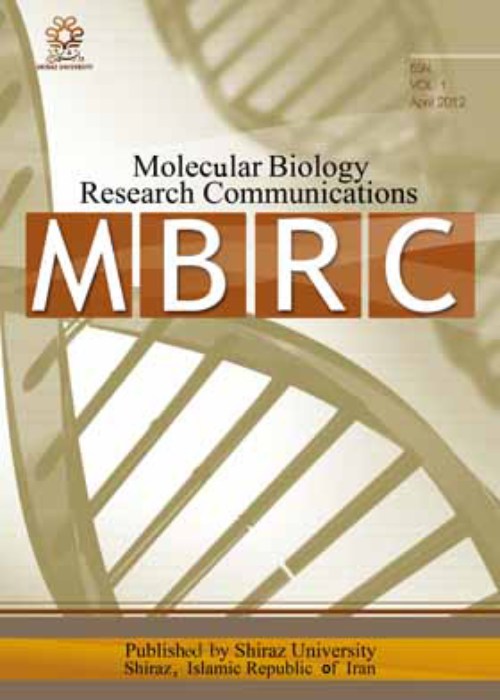فهرست مطالب

Molecular Biology Research Communications
Volume:11 Issue: 4, Dec 2022
- تاریخ انتشار: 1401/11/23
- تعداد عناوین: 5
-
-
Pages 155-166Pandemic coronavirus causes respiratory, enteric and sometimes neurological diseases. Proteome data of individual coronavirus strains were already reported. Here we investigated of SARS-CoV-2 ssRNA and protein of spike, envelope and membrane to determine stress adaptation profile. Thermodynamic properties, Physicochemical behaviour and, amino acid composition along with their RMSD value was analysed. Thermodynamic index of SARS-CoV2 spike, envelope and membrane ssRNA is unstable in higher temperature. Presence of higher proportion of polar with positive and negative charged amino acid residues into spike (S), envelope (E) and membrane (M) protein indicate the lower stress adaptability pattern. Our study represented several unstable pockets into S, E and M proteins of SARS-CoV-2 against different abiotic stresses, specifically higher in spike protein. Contact with heat through solvent may denature the architectural network of SARS-CoV-2 spike, envelope and membrane ssRNA and structural protein. The stress instability index of SARS-CoV-2 and the interactome profile of its transmembrane proteins may help to reveal novel factors for inhibiting SARS-CoV-2 growth.Keywords: SARS-CoV-2, Spike, Membrane, Envelope, stress, Stability Pocket
-
Pages 167-172Human tears can be used as a noninvasive source of genetic materials and biomarkers in the prognosis and diagnosis of ocular and non-ocular diseases. The present protocol is a novel direct RNA extraction method from tears. This study aims to provide a suitable method for direct extraction of RNA from tears with high quality and quantity. In this study, we develop a TRIzol base protocol for direct RNA extraction from human tears. quality and quantity of extracted RNA measured by calculation of 260/280 UV absorption ratio using Nanodrop and real-time PCR. RNA was extracted with this modified method and a purified (260/280 UV absorption ratio between 1.8 to 2 and a high yield of total RNA, on average 95 μg, from tears was extracted. In conclusion, we developed an easy and suitable method for direct extraction of total RNA from tears with high quality and quantity.Keywords: RNA, Extraction method, Human tears, Biomarkers
-
Pages 173-181Papillary thyroid carcinoma (PTC) is the most common endocrine cancer. However, the role of biomechanics in the development and progression of PTC is obscure. The microarray dataset GSE104005 was examined to identify important microRNAs (miRNAs or miRs) and their probable roles in the carcinogenesis of PTC. The gene expression omnibus (GEO) database was used to obtain the data. R was used to access the differentially expressed miRNAs (DEMs) and genes (DEGs). The multiMiR software was used to predict DEM targets. To validate the top DEMs and DEGs, thirty tissue samples were obtained from PTC patients who had their thyroids removed and compared with 30 normal samples. The total RNA content of the tumor and corresponding non-tumoral adjacent samples were purified and converted to cDNA. Expression levels of top dysregulated miRNAs and their target and predicted DEG were evaluated using the RT-qPCR method. miR-182 and miR-183 were top upregulated miRs and miR-30d was the most downregulated miR among DEMs. Furthermore, FOXO1 which was shown to be targeted by aforementioned miRNAs, was the most downregulated genes among other DEGs. 10 hub nodes were detected by PPI construction. PTEN was the hub node with highest score. The in vitro gene expression analysis was also showed the same expression pattern in tissues. Significant increase in miR-182-5p and miR-183-5p expressions, as well as a significant decrease in FOXO1 and miR-30d-5p expressions, suggest that PTC cells may tend to preserve their autophagy capability.Keywords: Papillary thyroid carcinoma, Autophagy, mRNA, miRNA
-
Pages 183-186The molecular profile of hepatitis Delta in Afghanistan remains unclear yet, therefore this study addresses the genotype of HDV among HBsAg carriers in Afghanistan. In total 234 HBsAg-positive sera were examined by chemiluminescent micro-particle immunoassay to detect Anti-HDV antibodies. Serologically positive samples were later approved via real-time PCR test and subsequently, a 731 bp segment of the HDV Delta antigen RNA region was sequenced in the Illumina platform. The isolates were genotyped via distance matrix/UPGMA analysis using Kimura 2-parameter by MEGA7 software package program. The HBV/HDV coinfection rate among HBsAg carriers in Afghanistan was 2.1%. Finally, 4 samples successfully amplified Hepa titis delta antigen (HDAg) which Later in phylogenetic analysis, all resided in branch genotype I and were stored at GenBank with accession numbers MK799645, MK799646, MK799647, MK799648. The HDV genotypic variations in the Afghan HBsAg carriers may be homogenous and HDV-1 may be the predominant genotype in Afghanistan.Keywords: Hepatitis Delta, Genotype, Phylogenetic analysis, Afghanistan
-
Page 187
Dear Editor, We would like to share ideas on the publication “Characterization of polymorphisms in CFI and ARMS genes and their association with exudative age-related macular degeneration in Algerian patients [1].” According to Abid et al., this work enriches the bank of data pertaining to the CFI and ARMS2 genes by disclosing for the first time the allelic and genotypic frequencies of these genes' polymorphisms that define the Algerian population [1]. Exudative age-related macular degeneration might or might not be impacted by the hereditary component. The effect of a polymorphism is investigated in this study. We both concur that exudative age-associated macular degeneration may be related to the underlying genetic component under research. However, exudative age-related macular degeneration has been linked to numerous genetic variations. Examples of gene polymorphisms include selectin and tumor necrosis factor-alpha polymorphisms [2, 3]. Future research should examine the implications of unexpected, possibly perplexing genetic variants.
Keywords: Polymorphism, macular, degeneration


